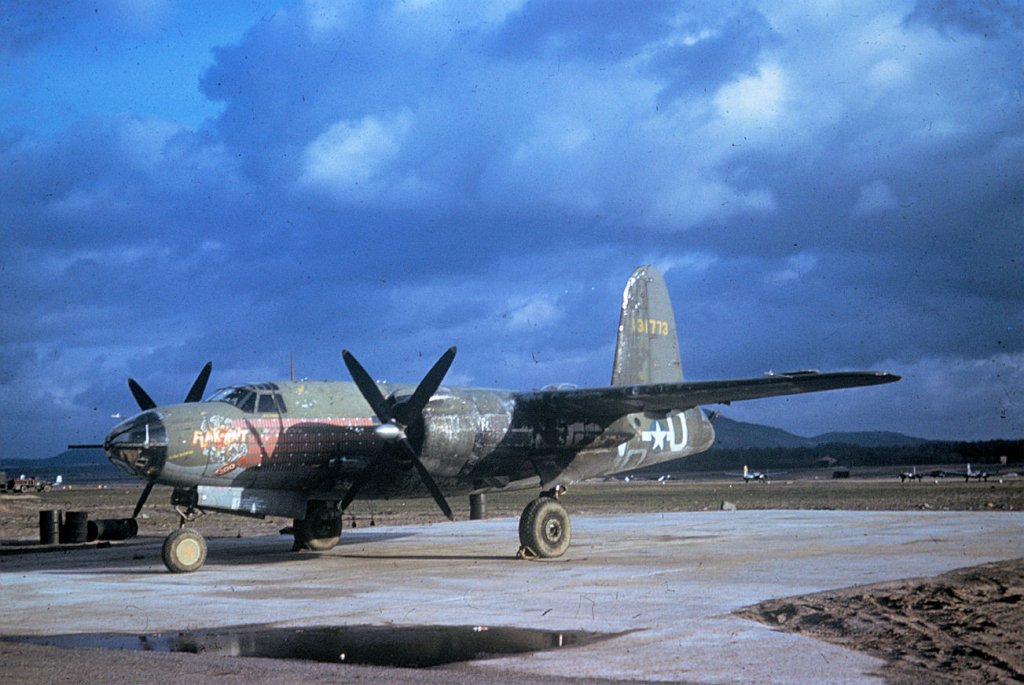Aircraft are insanely useful. They bring the BRRRTTTT, they fire rockets and they allow aircrews to conduct reconnaissance. If you’re in a shady situation or an all-out firefight, you want a bunch of friends in the sky, pronto. But they’re also quite fragile, typically breaking apart after a few solid hits. But there are some aircraft and crews who manage to keep going after damage that would normally turn it into a fireball.
Here are 5 aircraft that have stuck with us:
1. Flak-Bait

The aptly named Flak-Bait, a B-26 Marauder, became the most battle-hardened bomber of World War II after it completed 200 missions and suffered 1,000 battle scars. The Smithsonian thinks the plane flew 206 missions, but historians do quibble over the exact total.
The plane rolled off the line in Baltimore in April 1943 and went into combat the following August. The plane really was flak bait, too, taking damage on nearly every mission. It flew 100 missions in its first year and then flew another three missions just on D-Day.
By the end of its career, the plane didn’t have a single panel without damage.
2. “Queer John”
Queer John was a OH-6 Cayuse, better known at the time as the Loach. The Loach gained fame for a few things. The Vietnam-era scout helicopter set records for speed, endurance, and rate of climb. And it crashed easily and often. But the helicopter was so reliable in a crash that pilots told each other, “If you have to crash, do it in a Loach.”

One Loach epitomized this: Queer John. The helicopter survived seven crashes, according to an Army story from the period. And Sgt. James Thompson, a gunner quoted in that article, said, “He’s been through a lot of wear and tear, but I think he’s got a lot more hours to go. He’s got 61 patches on him from bullets and shrapnel.”
According to the same article, no one knew how Queer John got its name.
3. Guns-a-Go-Go
A barely remembered version of the C-47 flew in Vietnam: The armored gunship with multiple cannons and rocket launchers. The Army created four experimental ACH-47As in order to protect troops during air assaults. These bad boys slaughtered enemy soldiers and took massive punishment with little effect. They boasted 2,681 pounds of additional armor and went by the callsign “Guns-a-Go-Go.”

Of the four converted helicopters, only one was ever lost to enemy fire. Enemy troops forced it to the ground and then saturated it with mortar fire as the crew successfully escaped. One of the helicopters is still around and on display at Redstone Arsenal, Alabama.
4. Killer Chick’s A-10
During the Invasion of Iraq, troops fighting the Battle of Baghdad ran into serious resistance. Iraqi troops attempted a last-ditch defense against the 3rd Infantry Division. Air Force Capt. Kim Campbell, call sign Killer Chick, came in to help with gun and rocket runs on the North Baghdad Bridge.

Killer Chick flew right into the maelstrom even as Iraqi air defense units targeted her. After she fired her weapons, an Iraqi missile caught her tail, knocking out the hydraulic systems and sending the plan into a spiral. Campbell switched the mechanical controls and successfully flew the plane back despite massive damage to the tail, fuselage, and wings. The plane and Campbell landed safely and Campbell went back up the next day.
We’re not sure if the plane or the pilot was tougher.
5. Zivi Nedivi’s F-15
The F-15 is a legendary plane for a reason. It has never been shot down in aerial combat and has over 100 kills. The plane was a bit of an accident, designed in response to counter the MiG-25 before America discovered that the MiG-25 wasn’t as good as we thought.

But while the F-15 is effective and designed to take a lot of abuse, Israeli pilot Zivi Nedivi managed to push it past what anyone thought was possible. Nedivi collided with an A-4 Skyhawk during a training exercise. The crash sent him into a rapid roll, and he prepared himself and his navigator to eject. But he used the afterburners to stabilize the plane and decided it was stable enough to try and land.

When he got to the ground, he found out that he had lost an entire wing. But the F-15’s fuselage is designed to help provide lift and keep the plane steady, and it worked so well that Nedivi could fly and land on just one wing.


